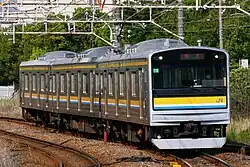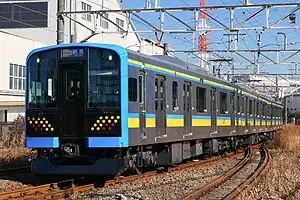| Tsurumi Line | |||
|---|---|---|---|
| JI | |||
 Two Tsurumi Line 205-1100 series trains at Tsurumi Station, May 2006 | |||
| Overview | |||
| Owner | |||
| Locale | Kanagawa Prefecture, Japan | ||
| Termini | |||
| Stations | 13 | ||
| Service | |||
| Type | Heavy rail | ||
| Rolling stock | |||
| History | |||
| Opened | 10 March 1926 | ||
| Technical | |||
| Line length | 7.0 km (4.3 mi) | ||
| Track gauge | 1,067 mm (3 ft 6 in) | ||
| Electrification | 1,500 V DC (Overhead line) | ||
| Operating speed | 85 km/h (53 mph) | ||
| Train protection system | ATS-P | ||
| |||
The Tsurumi Line (Japanese: 鶴見線, romanized: Tsurumi-sen) is a group of 3 railway lines operated by East Japan Railway Company (JR East) in Kanagawa Prefecture, Japan. Originally built to service the port and adjacent industrial area, the lines provide passenger services (especially for local workers) along a line between Tsurumi Station in Tsurumi-ku, Yokohama and Ōgimachi Station in Kawasaki-ku, Kawasaki, and 2 short branches with a total length of track to 9.7 km (6.0 mi). The gauge is 1,067 mm (3 ft 6 in), two sections of the line have double track and the line is electrified at 1,500 V DC.
Japan Freight Railway Company (JR Freight) operates on three segments of the line, often to carry petroleum and other chemicals from the numerous refineries and factories in the area. The line is also used to carry jet fuel from the US Navy fuel depot near Anzen Station through the Musashino Line to Yokota Air Base in west Tokyo.
Station list
- All stations are located in Kanagawa Prefecture.
- All trains stop at every station, except for trains to/from Ōkawa which pass Musashi-Shiraishi.
Main Line
| No. | Station | Japanese | Distance (km) | Transfers | Tracks | Location | |
|---|---|---|---|---|---|---|---|
| Between Stations |
From Tsurumi | ||||||
| JI01 | Tsurumi | 鶴見 | - | 0.0 | JK Keihin-Tōhoku Line KK Keikyu Main Line (Keikyū-Tsurumi) |
∥ | Tsurumi-ku, Yokohama |
| JI02 | Kokudō | 国道 | 0.9 | 0.9 | ∥ | ||
| JI03 | Tsurumi-Ono | 鶴見小野 | 0.6 | 1.5 | ∥ | ||
| JI04 | Bentembashi | 弁天橋 | 0.9 | 2.4 | ∥ | ||
| JI05 | Asano | 浅野 | 0.6 | 3.0 | JI Tsurumi Line (Umi-Shibaura Branch) | ∥ | |
| JI06 | Anzen | 安善 | 0.5 | 3.5 | JI Tsurumi Line (Ōkawa Branch) | ∥ | |
| JI07 | Musashi-Shiraishi | 武蔵白石 | 0.6 | 4.1 | ∥ | Kawasaki-ku, Kawasaki | |
| JI08 | Hama-Kawasaki | 浜川崎 | 1.6 | 5.7 | JN Nambu Line (Branch Line) | ∨ | |
| JI09 | Shōwa | 昭和 | 0.7 | 6.4 | | | ||
| JI10 | Ōgimachi | 扇町 | 0.6 | 7.0 | | | ||
Umi-Shibaura Branch
| No. | Station | Japanese | Distance (km) | Transfers | Tracks | Location | |
|---|---|---|---|---|---|---|---|
| Between Stations |
From Tsurumi | ||||||
| JI05 | Asano | 浅野 | - | 3.0 | JI Tsurumi Line (Main Line) | ∥ | Tsurumi-ku, Yokohama |
| JI51 | Shin-Shibaura | 新芝浦 | 0.9 | 3.9 | ∨ | ||
| JI52 | Umi-Shibaura | 海芝浦 | 0.8 | 4.7 | | | ||
Ōkawa Branch
| No. | Station | Japanese | Distance (km) | Transfers | Tracks | Location | |
|---|---|---|---|---|---|---|---|
| Between Stations |
From Tsurumi | ||||||
| JI06 | Anzen | 安善 | - | 3.5 | JI Tsurumi Line (Main Line) | ∥ | Tsurumi-ku, Yokohama |
| JI61 | Ōkawa | 大川 | 1.6 | 5.1 | | | Kawasaki-ku, Kawasaki | |
Rolling stock
- 205-1100 series 3-car EMUs (since August 2004)
- E131-1000 series 3-car EMUs (since 24 December 2023)
Three-car 205-1100 series EMU trainsets modified from former 205-0 series trainsets were introduced on the Tsurumi Line from 25 August 2004.[1] Nine 205-1100 series 3-car trains operate on the line.
Eight new-build 3-car E131-1000 series EMU trainsets were introduced on the line from 24 December 2023 as a successor to the 205-1100 series fleet.[2][3]
 A Tsurumi Line 205-1100 series EMU, May 2023
A Tsurumi Line 205-1100 series EMU, May 2023 A Tsurumi Line E131-1000 series EMU, January 2024
A Tsurumi Line E131-1000 series EMU, January 2024
Former
- KuMoHa 12 (Ōkawa Branch Line service, from December 1972 until March 1996)
- 72 series (from 1972 until January 1980)
- 101 series (from 1980 until March 1992)
- 103 series (from 2 August 1990 until 17 March 2006)
 A KuMoHa 12 car on the Ōkawa Branch Line in 1992
A KuMoHa 12 car on the Ōkawa Branch Line in 1992 A 103 series train on the Tsurumi Line in 2005
A 103 series train on the Tsurumi Line in 2005
Freight
Locomotives seen hauling freight trains include the EF65 and DE10.
Other
A shuttle bus for Toshiba employees runs in a loop between Asano, Shin-Shibaura, and Umi-Shibaura stations on a schedule alternating with Tsurumi Line trains. Both the bus and the stops are marked with the Toshiba logo.
History
The Tsurumi Port Railway (鶴見臨港鉄道, Tsurumi Rinkō Tetsudō) opened the Bentembashi to Hama-Kawasaki line, including the branch to Okawa in 1926, and extended the mainline to Ogimachi in 1928. In 1930, the Tsurumi to Bentembashi section opened, the lines were electrified at 600 V DC, and passenger services commenced on both lines. The Asano to Shin-Shibaura section opened as a freight-only line in 1932, and was extended to Umi-Shibaura in 1940, with passenger services commencing upon the opening of the extension.
The company was nationalised in 1943, and in 1948 the voltage was increased to 1,500 V DC.
On 20 August 2016, station numbering was introduced with Tsurumi line stations being assigned station numbers between JI01 and JI10.[4][5] Station numbers were also introduced to the Umi-Shibaura branch (station numbers JI51 and JI52) as well as the Ōkawa branch (station number JI61).
 Tsurumi Rinko Railway MoHa 51 electric car in August 1939
Tsurumi Rinko Railway MoHa 51 electric car in August 1939 Tsurumi Rinko Railway MoHa 110 electric car number MoHa 110 in August 1939
Tsurumi Rinko Railway MoHa 110 electric car number MoHa 110 in August 1939
References
- ↑ "鶴見線に205系先頭車化改造車1100代が登場" [205-1100 series with modified end cars appear for Tsurumi Line]. Railway Journal. Japan: Tetsudō Journal. 38 (457): 92. November 2004.
- ↑ E131系1000番代が鶴見線で営業運転を開始 [E131-1000 series begins operation on the Tsurumi Line]. Japan Railfan Magazine Online (in Japanese). Japan: Koyusha Co., Ltd. 26 December 2023. Retrieved 26 December 2023.
- ↑ JR東日本,鶴見線にE131系を導入 [JR East to introduce E131 series to Tsurumi Line]. Japan Railfan Magazine Online (in Japanese). Koyusha Co., Ltd. 24 July 2023. Retrieved 24 July 2023.
- ↑ "⾸都圏エリアへ 「駅ナンバリング」を導⼊します" [Introduce “station numbering” to the Tokyo metropolitan area] (PDF). jreast.co.jp (in Japanese). 6 April 2016. Archived from the original (PDF) on 7 December 2022. Retrieved 7 January 2023.
- ↑ Kusamachi, Yoshikazu (7 April 2016). "JA・JK・JT・AKB…JR東日本、首都圏で駅ナンバリングなど導入へ" [JA, JK, JT, AKB … JR East to introduce station numbering in the Tokyo metropolitan area]. Response Automotive Media (in Japanese). Archived from the original on 6 August 2022. Retrieved 7 January 2023.
External links
- Stations of the Tsurumi Line (JR East) (in Japanese)
